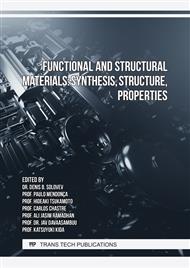[1]
N. Lorenzin, A. Abanades, A Review on the Application of Liquid Metals as Heat Transfer Fluid in Concentrated Solar Power Technologies, International journal of hydrogen energy. 222 (2016) 6990.
DOI: 10.1016/j.ijhydene.2016.01.030
Google Scholar
[2]
J. Pacio, A. Fritsch, C. Singer, R. Uhlig, Liquid Metals as Efficient Coolants for High-Intensity Point-Focus Receivers: Implications to the Design and Performance of Next-Generation CSP Systems, Energy Procedia. 49 (2014) 647.
DOI: 10.1016/j.egypro.2014.03.070
Google Scholar
[3]
K. Niedermeier, H.J. Flesch, L. Marocco, Th. Wetzel, Assessment of Thermal Energy in a Sodium-based CSP Plant Applied Thermal Engineering. 107 (2016) 386.
DOI: 10.1016/j.applthermaleng.2016.06.152
Google Scholar
[4]
N.N. Oshkanov, O.M. Saraev, M.V. Bakanov, P.P. Govorov, 30 Years of Experience in g the BN-600 Sodium-Cooled Fast Reactor Atomic Energy. 108 (2010) 234.
DOI: 10.1007/s10512-010-9283-2
Google Scholar
[5]
D. Gorse-Pomonti, V. Russier, Liquid Metals for Nuclear Applications, Journal of Non. 353 (2007) 3600.
DOI: 10.1016/j.jnoncrysol.2007.05.175
Google Scholar
[6]
H.U. Borgstedt, C. Guminski, Solubilities and Solution Chemistry in Liquid Alkali Metals Monatshefte fuer Chemie, Chemical Monthly. 131 (2000) 917.
DOI: 10.1007/s007060070046
Google Scholar
[7]
M.-L. Saboungi, D. Caveny, I. Bloom, M. Blander, The Coordination Cluster Theory: Multicomponent Systems Metallurgical Transactions. 18A (1987) 1779.
DOI: 10.1007/bf02646209
Google Scholar
[8]
V.V. Semenov, I.E. Lyublinski, V.P. Krasin, A.V. Vertkov, S.I. Soyustova, A.E. Potapova, Corrosion Resistance of V-4Ti-4Cr Alloy in Convection Flow of Eutectic Na-K Alloy, Inorganic Materials: Applied Research. 6 (2015) 133.
DOI: 10.1134/s2075113315020148
Google Scholar
[9]
V.I. Nikitin, Physicochemical Phenomena in the Action of Liquid Metals on Solid (Moscow: Atomizdat Press), 1967, p.441.
Google Scholar
[10]
V.P. Krasin, S.I. Soyustova, Comparison of Liquid Metal Solution Model Predictions with Data of Niobium with Liquid Sodium, J. Nucl. Mater. 451 (2014) 24.
DOI: 10.1016/j.jnucmat.2014.03.023
Google Scholar
[11]
C.H.P. Lupis, Chemical Thermodynamic of Materials (Amsterdam: North-Holland Press), 1983, p.160.
Google Scholar
[12]
R.L. Klueh, Effect of Oxygen on Niobium-Sodium Compatibility Corrosion, USA. 27 (1971) 342.
DOI: 10.5006/0010-9312-27.8.342
Google Scholar
[13]
B.J. Shaiu, P.C.S. Wu, P. Chiotti, Thermodynamic Properties of the Double Oxides of Cr, Ni and Fe, J. Nucl. Mater. 67 (1977) 13.
Google Scholar
[14]
M.G. Barker, D.J. Wood, The Corrosion of Chromium, Iron and Stainless Steel in sodium Less-Common Metals. 35 (1974) 315.
DOI: 10.1016/0022-5088(74)90243-4
Google Scholar
[15]
A.W. Thorley, C. Tyzack, Proc. Conf. Liquid Alkali Metals, BNES, Nottingham, 1973, p.257.
Google Scholar
[16]
M.V. Polley, G. Skyrme, An Analysis of the Corrosion of Pure Iron in Sodium Loop, Mater. 66 (1977) 221.
Google Scholar
[17]
M. Blander, M.-L. Saboungi, P. Cerisier, A Statistical Mechanical Theory for Activity of a Dilute Solute in a Binary Solvent Metallurgical Transactions. 10B (1979) 613.
DOI: 10.1007/bf02662564
Google Scholar


